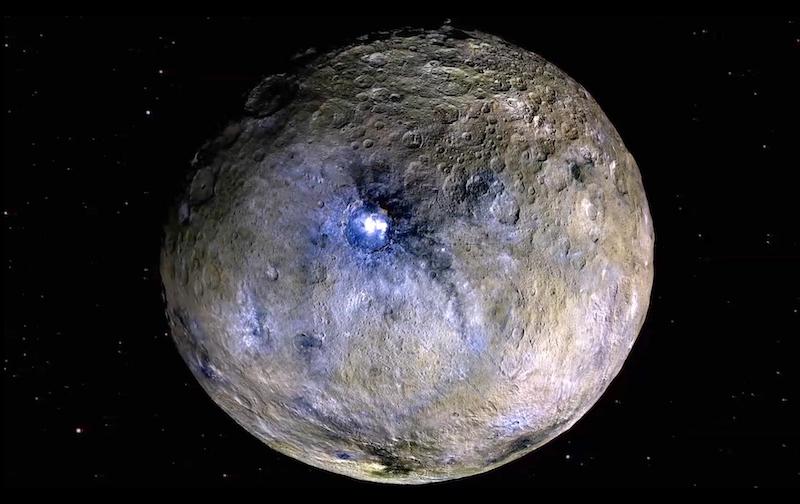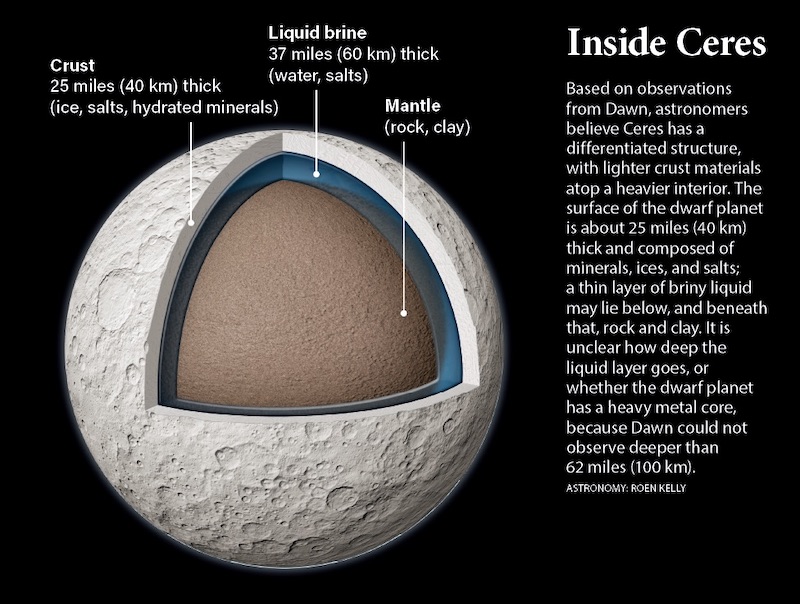
Dwarf planet Ceres’ icy crust
The dwarf planet Ceres, which orbits the sun in the asteroid belt, is an enigmatic world, with bright spots of salts, a huge ice volcano and, likely, salty water below its surface. Now, scientists have found more evidence that Ceres’ icy crust is indeed rich in water ice. And, they think, bits of water ice are lying exposed on the surface. Ultimately, they said, these fragments were flung out by impacts from asteroids or other rocky debris.
Researchers at the Planetary Science Institute (PSI) announced the intriguing research last week. Additionally, their new peer-reviewed paper was published in Geophysical Research Letters on July 21, 2021.
High concentrations of hydrogen detected by Dawn
In this case, the icy deposits were located by NASA’s Dawn spacecraft in Occator Crater. Interestingly, this is the same crater where the brightest and largest salt deposits had previously been found. As a matter of fact, those deposits stood out significantly against the surrounding darker landscape, almost looking like city lights.


Specifically, the new ice deposits were detected by the Gamma Ray and Neutron Detector (GRaND) instrument on Dawn. Notably, the deposits appeared as concentrations of hydrogen, seen by Dawn as it orbited close to the surface. As explained in the paper:
The distribution of subsurface ice within this outer layer was inferred from measurements of hydrogen by Dawn’s Gamma Ray and Neutron Detector. Special operations during Dawn’s last mission phase brought the spacecraft close to the surface, enabling measurements within and around a large, young crater called Occator. Anomalously high concentrations of hydrogen were detected, suggesting the impact that formed Occator excavated water rich materials from the crust and deposited them on the surface.
Ice deposits near the surface in Occator Crater
As might be expected, the hydrogen signatures are interpreted to be deposits of water ice. The researchers say these ice deposits are bits of the icy crust that have been exposed on the surface of Ceres by impacts. The impacts churn up the upper parts of the crust, leaving the icy fragments scattered on the surface.
For scientists, these deposits provide valuable clues about Ceres’ interior and evolution. Also, researchers can use them to better determine the surface age of Ceres and the thermophysical properties of the regolith on the surface. Tom Prettyman at PSI, who led the research, stated:
We think that ice has survived in the shallow subsurface during the roughly 20 million years following the formation of Occator. Similarities between the global distribution of hydrogen and the pattern of large craters suggest impact processes have delivered ice to the surface elsewhere on Ceres. This process is accompanied by the loss of ice by sublimation caused by heating of the surface by sunlight.
An ice-rich crust
Not surprisingly, the results support previous studies showing that Ceres’ crust is rich in water ice. As the paper continued:
Comparison of the global distribution of hydrogen with the pattern of large craters on Ceres further supports excavation of crustal ice by impacts. Results confirm that Ceres’ crust is rich in water ice and show that ice can survive in materials ejected by impacts into airless, icy bodies.

For example, according to Prettyman:
The impact that formed Occator would have excavated crustal materials as deep as 10 km (about 6 miles). So, observed enhancements in the concentration of hydrogen within the crater and ejecta blanket support our interpretation that the crust is ice rich. The findings reinforce the emerging consensus that Ceres is a differentiated body in which ice separated from rock to form an icy outer shell and subcrustal ocean.
Smaller, water-rich bodies, including the parent bodies of the carbonaceous chondrite meteorites, may not have experienced differentiation. So, the findings could have implications for the evolution of icy bodies, small and large. More broadly, as an ocean world, Ceres could be habitable and is therefore an attractive target for future missions.
A remarkable mission
As planned, Dawn’s mission came to an end on October 31, 2018, when the spacecraft ran out of fuel. It was the first spacecraft to orbit two different extraterrestrial bodies, Vesta and Ceres. In addition, it was also the first to orbit an object in the main asteroid belt (Vesta), and the first to visit a dwarf planet (Ceres). Dawn first went into orbit around Ceres in 2015, and previously arrived at Vesta in 2011.
Bottom line: Scientists have found evidence that fragments of Ceres’ icy crust are sitting on the surface of the dwarf planet, exposed by impacts from asteroids or other rocky debris. For scientists, the finding provides new clues about the interior and evolution of this enigmatic world.











